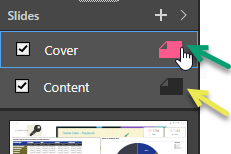Add a variable that will be replaced at runtime with some basic information from your presentation. This information can include slide numbers, the current date, the author name, and so on, and can be added either to a particular slide or, if you want it to appear on every slide, to the master. This allows you to provide context about the presentation for the reader, such as who created the presentation, when, how many pages it has, which page you are on, and so on.
When you add a text field to your presentation, it is added to your working file as a variable tag (for example, #SlideName). You can format this text field exactly as you would any text, by dragging and resizing the text box on the canvas or by selecting the text box and changing the formatting for the text from the Component ribbon.
This is the simplest type of dynamic text available in Present Pro. Other dynamic text options allow you to replace placeholders with slicer data or pull data from matrix grids into text fields, among other dynamic functionalities.
- Click here for other Dynamic asset features
Text Fields
You can add the following basic text field variables:
- Current Date: Today's date.
- Create Date: The date the presentation was created.
- Modified Date: The date the presentation was last modified.
- Created By: The name of the user who created the presentation.
- Modified By: The name of the user who last modified the presentation.
- Presentation Title: The title that the presentation was saved with.
- Description: The description that was added to the presentation when it was saved. Note: This description is captured in the Save dialog.
- Slide Number: The "page" number for this slide. For example, "1" if this is slide 1 of 3.
- Total Slides: The total number of slides in the presentation.
- Slide Name: The name of the slide as defined in the slides panel.
Advanced text field options that require additional configuration and are described elsewhere:
- Slide Insights: Adds AI-driven slide-wide insights to a paragraph of text dynamically, based on the slide content.
- Model Processed Date: Adds the date when the selected data model was last processed.
- Table of Contents: Adds a table of contents to the slide. Note: You cannot add a TOC from the overhead menu as it is not dynamic text.
Add text field variables to your presentation
Select a location for your text field
Where you want to include your text field depends on your requirements. For example, you may want to add the name of the user who created the slide to a single slide that contains document version details, or you may want to add it to every page as part of the footer:
- To add your variable to a single slide, open the slide on the canvas by selecting it in the Slides panel.
- To add your variable to all slides or to the cover page master, select the master option at the top of the Slides panel:
- Select Cover (green arrow below) to add your variable to the cover of the presentation.
- Select Content (yellow arrow) to add your variable to the master that controls the appearance of every other slide in the presentation.

Note: Adding your variable to the Content Master effectively adds the variable to every slide in the presentation.
Add the Text Field variable
Add new from the Toolbox
To create a new text field and add your selected variable to it:
- From the Toolbox, right-click Add Text Field > Text Field Name.
- Click the canvas at the point where you would like to add your variable.
The #Variable is added to the canvas. This variable will be replaced at runtime.
Add to an existing text field
If you already have a text field on your slide, and you want to add one of the text field variables to it:
- Select the text field on the canvas.
- From the Component ribbon, click Dynamic Text > Text Field Name.
The #Variable is added to the pre-existing text field. This variable will be replaced at runtime and the other text in the text field will remain as is.
Add to a tootip
You can add any of these text field variables (and therefore their replacement values) to dynamic tooltips by selecting them in the Tooltip Designer. This allows you to refer to, say, a slide name in your tooltip text without the worry it may fall out of sync with the slide's actual name later.
- For more information, see Dynamic Tooltips in Present Pro
Format your text field (optional)
You can format the text and text box on your slide by resizing the box, moving it to a more appropriate location on the canvas, changing the font formatting for its content, and so on. As with any other content item, you can use the standard editing options on the right-click menu, the component ribbon, and the canvas to manage your text formatting.
- Click here for more about canvas options (resize, move, and so on)
- Click here for more about formatting from the Component ribbon
Check your text field variable
You can check that the correct replacement is made at runtime by clicking the Run button or F2 on your keyboard for a preview. The #Variable value that you saw in your editor is replaced by the correct value for the presentation at runtime:

Note: The tag #StoryboardTitle identifies the Presentation Title text field in the editable version of your presentation. When the presentation is launched at runtime, this tag is replaced with the presentation name as shown in the preceding image.
Tip: Optionally, you can choose not to show variable text fields or dynamic text fields (created from the data model) with a highlighted background in the editor. For more information, see Highlight dynamic text in Present Pro.